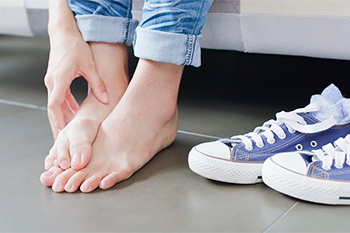Garner (919) 661-4150
February 2023
Various Reasons for Toe Pain

The bones in the toes can be easier to fracture than other bones. They are small in size and can be stubbed or jammed against a piece of furniture, often causing pain and discomfort. Additional forms of toe pain can include bunions, ingrown toenails, or the toe may become sprained from an injury. If the toe is thought to be broken or sprained, an X-ray is often performed, which is successful in determining which type of injury it may be. Prompt medical attention is generally sought for an ingrown toenail, and relief may come from partially or completely removing the nail. A bunion is a bony area that develops on the side of the big toe. It may feel better when larger shoes are worn, and a protective pad is worn over it. In severe cases, the bunion may cause the other toes to shift toward each other, and surgery may be a necessary treatment method for permanent removal. If you have toe pain for any reason, it is suggested that you seek the counsel of a podiatrist who can determine what the cause is, and treat it accordingly.
Toe pain can disrupt your daily activities. If you have any concerns, contact Chukwuma Ukata, DPM of Advanced Carolina Foot and Ankle Center. Our doctor can provide the care you need to keep you pain-free and on your feet.
What Causes Toe Pain?
Most severe toe pain is caused due to a sports injury, trauma from dropping something heavy on the toe, or bumping into something rigid. Other problems can develop over time for various reasons.
Toe pain can be caused by one or more ailments. The most common include:
- Trauma
- Sports injury
- Wearing shoes that are too tight
- Arthritis
- Gout
- Corns and calluses
- Hammertoe
- Bunions
- Blisters
- Ingrown toenails
- Sprains
- Fractures (broken bones)
- Dislocations
When to See a Podiatrist
- Severe pain
- Persistent pain that lasts more than a week
- Signs of infection
- Continued swelling
- Pain that prevents walking
Diagnosis
In many cases the cause of toe pain is obvious, but in others, a podiatrist may want to use more advanced methods to determine the problem. These can range from simple visual inspections and sensation tests to X-rays and MRI scans. Prior medical history, family medical history, and any recent physical traumatic events will all be taken into consideration for a proper diagnosis.
Treatment
Treatments for toe pain and injuries vary and may include shoe inserts, padding, taping, medicines, injections, and in some cases, surgery. If you believe that you have broken a toe, please see a podiatrist as soon as possible.
If you have any questions please feel free to contact our office located in Garner, NC . We offer the newest diagnostic tools and technology to treat your foot and ankle needs.
Obesity Negatively Affects the Feet

Studies have shown there is a negative relationship between body mass index, foot biomechanics, and the feet. In short, the heavier you are, the more likely you are to experience foot, heel, and ankle pain. Excess weight can also contribute to gout, osteoarthritis, plantar fasciitis, flat feet, and overpronation. It is commonly held that the feet can absorb from three to six times the weight of your body in force, such as walking, running, and jumping. A BMI over 30 doubles the risk of an ankle injury, but losing even five pounds can reduce the amount of pressure in the feet and ankles by 30 pounds. Some simple foot strengthening exercises such as scrunching up a towel with your toes can help reduce the effects of obesity. In addition, experts suggest wearing shoes that fit properly, provide ample arch support, and have adequate heel cushioning. And finally, a gradual weight loss regime can help to lighten the pressure on your feet. For more information on dealing with obesity and the resulting problems it may cause in the feet and ankles, please consult a podiatrist.
Obesity has become very problematic at this point in time and can have extremely negative effects on the feet. If you’re an obese individual and are concerned about your feet, contact Chukwuma Ukata, DPM from Advanced Carolina Foot and Ankle Center. Our doctor can provide the care you need to keep you pain-free and on your feet.
Obesity and Your Feet
Since your feet are what support your entire weight when standing, any additional weight can result in pain and swelling. Being overweight is one of the main contributors to foot complications.
Problems & Complications
Extra Weight – Even putting on just a few extra pounds could create serious complications for your feet. As your weight increases, your balance and body will shift, creating new stresses on your feet. This uneven weight distribution can cause pain, even while doing the simplest tasks, such as walking.
Diabetes – People who are overweight are at serious risk of developing type-2 diabetes, which has a drastic impact on the health of your feet. As you get older, your diabetes might worsen, which could lead to loss of feeling in your feet, sores, and bruises. You could also become more prone to various infections.
Plantar fasciitis – Pressure and stress that is placed on muscles, joints, and tendons can trigger plantar fasciitis, which is an inflammation of tissue that forms along the bottom of the foot.
If you have any questions please feel free to contact our office located in Garner, NC . We offer the newest diagnostic and treatment technologies for all your foot and ankle needs.
Reminder: When Was the Last Time...?
Possible Relief Methods for Plantar Fasciitis

Many athletes suffer from a foot condition that is known as plantar fasciitis. It is a common ailment that comes from the repetitive force while participating in running and jumping activities. It may also affect people who wear shoes that do not fit correctly, or who have an abnormal foot structure. Additionally, it may happen to people who stand on hard surfaces for most of the day, or increase speed and distance too quickly while running. Plantar fasciitis happens as a result of an inflammation of the plantar fascia, which is the band of tissue that is found on the sole of the foot. It connects the heel to the toes, and an injury or a tear to the plantar fascia may result in the development of this condition. Heel pain is a common symptom of plantar fasciitis, and it may be worse in the morning after arising. Relief may be found when weight is kept off of the affected foot, and is frequently elevated while resting. Some patients have found success when specific stretches are done, and this may help to accelerate healing. If you have heel pain, it is strongly advised that you are under the care of a podiatrist who can properly diagnose and treat plantar fasciitis.
Plantar fasciitis is a common foot condition that is often caused by a strain injury. If you are experiencing heel pain or symptoms of plantar fasciitis, contact Chukwuma Ukata, DPM from Advanced Carolina Foot and Ankle Center. Our doctor can provide the care you need to keep you pain-free and on your feet.
What Is Plantar Fasciitis?
Plantar fasciitis is one of the most common causes of heel pain. The plantar fascia is a ligament that connects your heel to the front of your foot. When this ligament becomes inflamed, plantar fasciitis is the result. If you have plantar fasciitis you will have a stabbing pain that usually occurs with your first steps in the morning. As the day progresses and you walk around more, this pain will start to disappear, but it will return after long periods of standing or sitting.
What Causes Plantar Fasciitis?
- Excessive running
- Having high arches in your feet
- Other foot issues such as flat feet
- Pregnancy (due to the sudden weight gain)
- Being on your feet very often
There are some risk factors that may make you more likely to develop plantar fasciitis compared to others. The condition most commonly affects adults between the ages of 40 and 60. It also tends to affect people who are obese because the extra pounds result in extra stress being placed on the plantar fascia.
Prevention
- Take good care of your feet – Wear shoes that have good arch support and heel cushioning.
- Maintain a healthy weight
- If you are a runner, alternate running with other sports that won’t cause heel pain
There are a variety of treatment options available for plantar fasciitis along with the pain that accompanies it. Additionally, physical therapy is a very important component in the treatment process. It is important that you meet with your podiatrist to determine which treatment option is best for you.
If you have any questions, please feel free to contact our office located in Garner, NC . We offer the newest diagnostic and treatment technologies for all your foot care needs.
Does Your Child Have Athlete’s Foot?

Taking care of your toddler’s feet and helping them maintain proper foot health is one of the most important things that a parent can do. Caring for your toddler’s feet ensures that they can support your child as the child grows older. One important foot affliction to be on the lookout for in your child is known as athlete’s foot. Athlete’s foot is a fungal infection that can cause a red rash on the feet. Athlete’s foot is often spread between children in damp, warm, public places where children may walk around barefoot. For example, you might encourage your children not to walk around barefoot in their school’s gymnasium. Often, a case of athlete’s foot may be spread on the sides of public pools. Children will demonstrate blisters and red skin when they are affected by athlete’s foot. If you care about maintaining the health of your children, start by protecting against athlete’s foot. See a podiatrist for more information.
Athlete’s foot is an inconvenient condition that can be easily reduced with the proper treatment. If you have any concerns about your feet and ankles, contact Chukwuma Ukata, DPM from Advanced Carolina Foot and Ankle Center. Our doctor will treat your foot and ankle needs.
Athlete’s Foot: The Sole Story
Athlete's foot, also known as tinea pedis, can be an extremely contagious foot infection. It is commonly contracted in public changing areas and bathrooms, dormitory style living quarters, around locker rooms and public swimming pools, or anywhere your feet often come into contact with other people.
Solutions to Combat Athlete’s Foot
- Hydrate your feet by using lotion
- Exfoliate
- Buff off nails
- Use of anti-fungal products
- Examine your feet and visit your doctor if any suspicious blisters or cuts develop
Athlete’s foot can cause many irritating symptoms such as dry and flaking skin, itching, and redness. Some more severe symptoms can include bleeding and cracked skin, intense itching and burning, and even pain when walking. In the worst cases, Athlete’s foot can cause blistering as well. Speak to your podiatrist for a better understanding of the different causes of Athlete’s foot, as well as help in determining which treatment options are best for you.
If you have any questions please feel free to contact our office located in Garner, NC . We offer the newest diagnostic and treatment technologies for all your foot and ankle needs.







